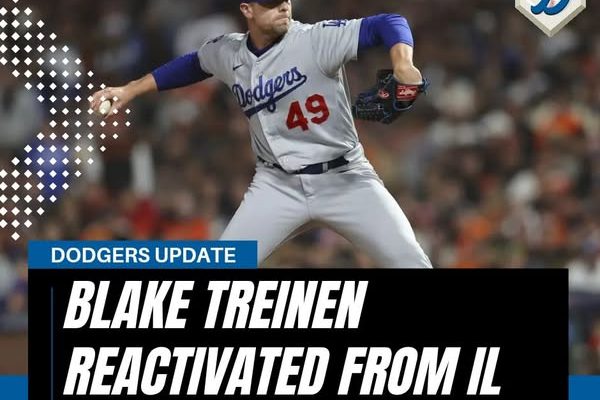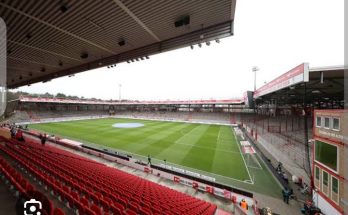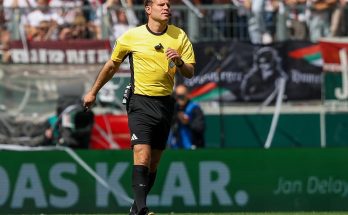The Los Angeles Dodgers made waves across Major League Baseball on Tuesday with the announcement that right-handed pitcher Blake Treinen has officially been reactivated from the Injured List. Additionally, the team has recalled promising left-handed pitcher Justin Wrobleski from Triple-A Oklahoma City, signaling another step in the club’s continual rotation management and postseason preparation. This update may appear routine to casual observers, but for anyone familiar with the inner workings of the Dodgers’ roster decisions and bullpen management strategies, these two moves carry massive implications for the club’s immediate future and their postseason aspirations.
Blake Treinen’s return is more than a rehabbed arm being reinserted into the bullpen. It’s the restoration of a powerful weapon that the Dodgers have sorely missed for much of the season. Treinen, when healthy, has been one of the most dominant and reliable relievers in the National League. Since joining the Dodgers in 2020, the veteran has consistently provided elite late-inning support, frequently deployed in high-leverage situations to neutralize the opposition’s top bats. His slider-sinker combination has baffled hitters and generated weak contact at elite levels, a crucial asset in tightly contested games.
The path back to the mound hasn’t been easy for Treinen. The 36-year-old has faced multiple setbacks over the last two seasons, including shoulder issues that raised concerns about the longevity of his effectiveness. There were questions in early spring about whether Treinen would ever return to full strength, or even contribute in a meaningful way this season. But over the last month, reports from the Dodgers’ training staff and glimpses during minor league rehab assignments painted a promising picture. He gradually ramped up his workload, facing minor league hitters across several appearances without incident, and more importantly, without pain. Scouts and insiders watching his velocity readings saw them return to normal levels, with his sinker once again touching the high 90s. Just as important, his pitch command—which had waned during early rehab sessions—sharpened significantly in recent outings, indicating not only physical recovery but also mechanical confidence.
Treinen’s reactivation comes at a pivotal point in the season for Los Angeles. The Dodgers find themselves engaged in a heated battle atop the National League standings, vying for both division supremacy and postseason seeding. While the offense has been dependable and the starting rotation has remained serviceable despite injuries, the bullpen has experienced a degree of volatility that has raised eyebrows. With key contributors like Evan Phillips and Brusdar Graterol occasionally stretched thin, the return of a veteran like Treinen provides both stability and versatility. Manager Dave Roberts will now have a trusted arm to insert into pressure-packed situations, whether it’s shutting down a rally in the seventh inning or preserving a one-run lead in the ninth.
In tandem with Treinen’s return, the Dodgers also made another move that may not garner the same headlines but is equally telling about the organization’s forward-looking mindset: the recall of Justin Wrobleski from Triple-A. Wrobleski, a 23-year-old lefty with a rising profile in the Dodgers’ farm system, has quietly built a case for major league readiness this season. He’s posted strong numbers in Triple-A, with a sub-3.00 ERA and a strikeout rate that places him among the top left-handed prospects in the Pacific Coast League. More impressive than his stat line, however, has been his poise on the mound. Dodgers insiders have noted his calm demeanor, his ability to pitch backwards in counts, and his development of a sharper slider to go alongside his already lively fastball.
The recall suggests that the Dodgers are not merely focused on plugging immediate holes, but rather on grooming the next wave of contributors for the stretch run and beyond. Wrobleski offers a fresh look out of the bullpen as a lefty who can go multiple innings, something the Dodgers have lacked at times this year. With veterans like Alex Vesia enduring bouts of inconsistency and Caleb Ferguson struggling with control issues, Wrobleski’s emergence provides Roberts with an alternate option—one that comes without the wear and tear of a long major league season.
Furthermore, this move may be a preview of how the Dodgers intend to approach the postseason roster puzzle. October baseball demands depth, particularly in the bullpen. Injuries, matchup intricacies, and extra-inning scenarios often require relievers to step up in unfamiliar roles. Wrobleski may be getting an early audition, a chance to prove his mettle in regular season pressure before potentially becoming a wildcard asset in the playoffs. This aligns with the Dodgers’ recent approach to bullpen construction, in which younger, untested arms are given chances late in the year to prove their worth. Just last season, pitchers like Ryan Pepiot and Michael Grove played vital roles down the stretch after midseason promotions. Wrobleski’s call-up feels like it’s cut from the same cloth.
This dual move—activating Treinen and recalling Wrobleski—also reflects the Dodgers’ broader organizational philosophy: blending experience with youth, maximizing options, and staying ahead of the curve in terms of roster flexibility. It’s no secret that the Dodgers’ front office under Andrew Friedman prioritizes roster depth and values players who offer versatility. Treinen is the known quantity, the proven veteran returning at precisely the right time to fortify the bullpen. Wrobleski is the new blood, unproven but promising, with the kind of upside that could turn him into an October X-factor. Together, they represent two ends of the same strategic spectrum.
One cannot overlook the ripple effects these moves have on the rest of the roster. Someone had to be optioned or placed on the injured list to make room, and those decisions often come with consequences in terms of clubhouse dynamics and performance expectations. While the Dodgers have not immediately disclosed the corresponding roster moves, it is expected that either a struggling reliever or a position player was shifted to accommodate the new additions. The message is clear: performance matters, and the front office is not afraid to shake up the 26-man roster if it believes better options are available.
Fans should also consider the timing of these transactions. The trade deadline looms, and front offices across the league are making final assessments of what they have internally before exploring external additions. By reactivating Treinen and recalling Wrobleski now, the Dodgers get a brief window to evaluate their impact before potentially making bullpen-related trades. If Treinen returns to form and Wrobleski handles the spotlight well, the need for another high-leverage reliever via trade may be reduced. Conversely, if questions remain, it could push Friedman and the front office to be more aggressive at the deadline.
In Treinen’s case, there is also a strong emotional component. He has been part of the Dodgers’ recent success and was a key figure in their 2020 World Series championship run. His presence in the locker room brings intangible benefits, from leadership to mentorship of younger pitchers. Several Dodgers players have already voiced their excitement at his return, describing Treinen as someone whose preparation and mentality are contagious. In a clubhouse that has grown increasingly youthful, veterans like Treinen offer a stabilizing influence, helping to bridge the gap between raw talent and polished performance.
Meanwhile, Wrobleski’s arrival represents the Dodgers’ continued excellence in player development. Drafted out of Oklahoma State, he entered the system with solid but unspectacular projections. Yet under the Dodgers’ development infrastructure, he’s added velocity, refined his mechanics, and matured into a pitcher capable of getting big-league hitters out. His rise is a testament to the work being done in the minor leagues—a reminder that Los Angeles not only wins with big names and blockbuster deals but also by cultivating talent from within.
As the season barrels toward its final months, every roster decision carries added weight. For the Dodgers, Tuesday’s news wasn’t just about two pitchers changing status on a depth chart. It was about strengthening the spine of the team. It was about getting a warrior back on the battlefield in Treinen, and giving a hungry rookie his shot to carve out a place in a championship hunt. This is how great teams operate—not by standing pat, but by constantly evolving, adapting, and infusing new life into their roster.
With Treinen back and Wrobleski getting his call-up, the Dodgers bullpen just became more dangerous, more dynamic, and more difficult to predict. For opponents, that’s a nightmare. For fans, it’s another reason to believe that this team is building toward something special once again.



